FROM WATER WASTE TO EFFICIENCY: 10 REASONS TO SWITCH TO A COMMERCIAL DISHWASHER
The first dishwasher made its debut in 1850, shaking up how we viewed washing glasses and dishes. By 1886, it had been refined into the first modern dishwasher, designed with one main purpose: to clean dishes without causing any damage. More than a hundred years later, dishwashing machines are the backbone of professional kitchens.
Nowadays, industrial dishwashing is a requirement in many countries for restaurants, cafeterias, and hotels. These rules ensure that dishwashing is hygienic and of high quality, making it suitable for businesses in the HORECA sector around the globe.
However, in Southeast Asia, the use of industrial dishwashers hasn't been standardized across all professional food establishments, and handwashing is still the main method for sanitizing all kinds of tableware.
At first glance, this might not look like a big deal. But sticking with hand washing can actually be one of the least efficient practices in a modern professional kitchen, not to mention a major drain on essential resources like water and time in your business. Have you thought about the benefits of upgrading your professional kitchen and elevating your establishment?
Here are 10 reasons to ditch hand washing.
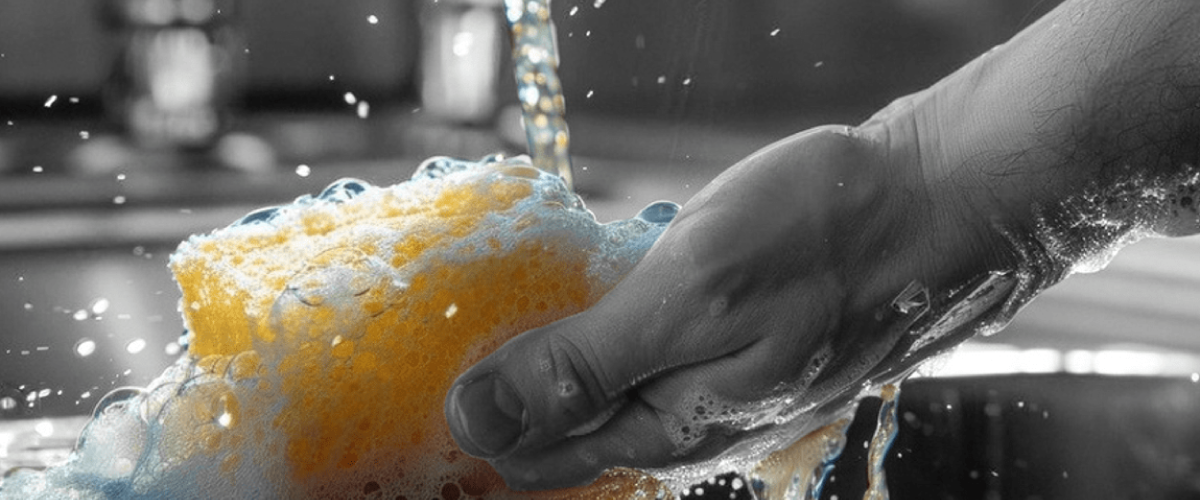
1. HOW MUCH ARE YOU SPENDING WHEN WASHING BY HAND?
It uses 2.2 liters per cycle,
washing up to equates to an average 18 pieces in less than 2 minutes consumption of just one tenth liters of the water you would use per piece of plates, which is handwashing!
In addition to saving water, this change has a positive impact on your operating costs and the environment, making every drop count. Can you imagine how much you could gain by being more efficient and sustainable?
Now, let's compare this to the efficiency of a Winterhalter dishwasher. In less than a year, an average restaurant with 300 daily services can save more than 250 m³ of water. Yes, more than 250,000 liters, simply by switching to professional equipment.
Washing dishes by hand may seem like a simple solution, but the numbers tell a different story. Every restaurant that operates this way uses hundreds of liters of water per day, which not only increases consumption but also increases monthly bills. And when it comes to detergents, traditional liquid products prove to be inefficient: you need more, you get fewer results, and, to top it all off, are less sustainable.
Manual washing: An operator consumes between 0.8 and 1.2 liters of water per piece washed.
Winterhalter:
To put it into perspective:
WINTERHALTER — 100 PARTS WASHES PER HOUR
VS
MANUAL WASH — 1,800 PARTS WASHES PER HOUR
These data are estimates and vary depending on the dishwashing equipment and the type of commercial establishment.
80% WATER SAVING
2. WHAT HAPPENS IN PROFESSIONAL KITCHENS?
During peak hours, the accumulation of utensils and dishes not only reduces available space but also impacts operational efficiency. As a result, many kitchens resort to impractical solutions:
- Hire more staff for the laundry area.
- Expand the space used for washing, reducing the useful area for other operations.
- Using areas not designed to store dishes, affecting the workflow.
Unfortunately, in Southeast Asia, even in high-end restaurants, dishwashing remains a neglected aspect of professional kitchen planning. This negatively impacts not only hygiene and efficiency, but also the overall customer experience.
Investing in a professional dishwasher like Winterhalter not only optimizes space, but also ensures flawless washing, reduces operating load, and eliminates unnecessary buildup.
A game-changing solution
MORE EFFICIENCY, LESS STRESS, BETTER RESULTS
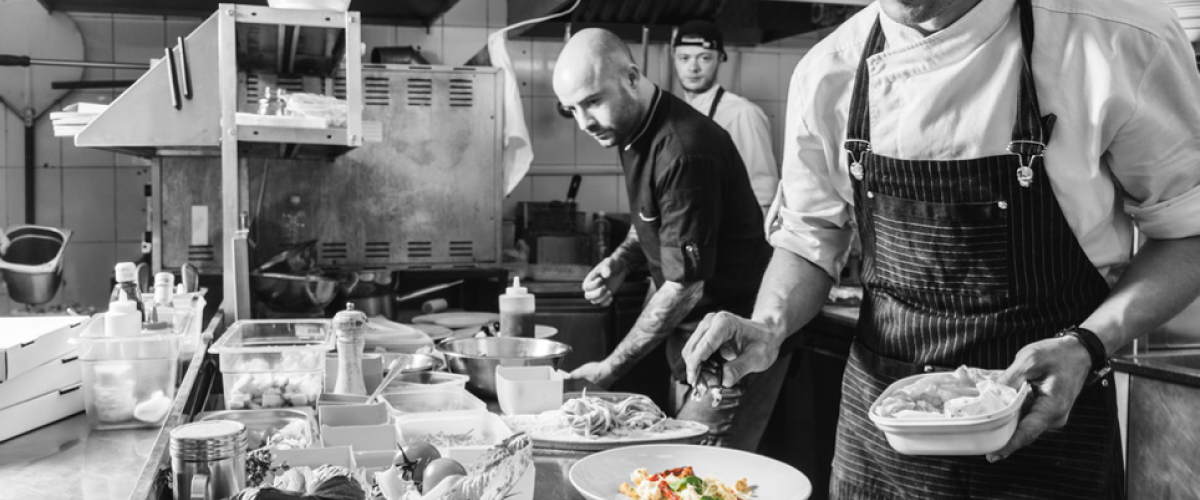
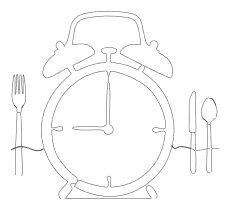

3. INEFFICIENCY
Operational delays: By spending more time on washing, other essential tasks are affected, delaying service and, often, closing the business.
Handwashing not only consumes water and detergents, but also an even more valuable resource: time. This process slows down operations, creates a buildup of dishes, and, during peak hours, can overwhelm your kitchen's capacity.
Increased stress for your team: Without an efficient system, workers face grueling workdays that can compromise their well-being and increase the risk of errors. This results in less-than-clean dishes, broken or damaged items, and poor hygiene standards.
Accumulation of dishes: During a busy hour, it's common for a restaurant to accumulate more than 600 items to be washed, overwhelming the space and staff.

4. BREAKAGE — HOW CAN YOU AVOID WEAR & TEAR?
THE HIDDEN COST OF BREAKAGE
To give you an idea, getting into a standard drink usually costs between $10 and $20.
- If you break one glass each day for five days a week, that adds up to a monthly cost of somewhere between $200 and $400. In just a year, these overruns can easily go over $1,000, affecting your profit margins.
- These costs often fly under the radar, but the overall effect can be quite substantial for any food and beverage business.
Physical damage: Plates that are hand wash can be subjected to pressure, temperature changes, and mishandling, leading to cracks, breakage, and early wear. Recurring costs: A restaurant experiencing busy demand spikes.
Washing dishes and glassware by hand can be quite a hassle and an expense that adds up fast. Just piling up items in the dishwasher can lead to some serious issues:
- You might find yourself dealing with daily breakages of fragile glasses or plates, which means you'll be replacing them all the time.
The answer is in upgrading your washing system. A Winterhalter professional dishwashing system is built to handle even the most fragile items, managing aspects like:
- Pressure: Modified to avoid physical harm.
- Temperature and exposure time: Ideal for keeping delicate glassware safe.
- Amount of detergent: Exact to safeguard delicate materials.
5. PERFECT SHINE, NO WORRIES
In the kitchen, the taste of dishes depends on the chef. In handwashing, the same is true: the results depend directly on who performs the task, leading to inconsistencies in cleanliness, shine, and efficiency.
Key questions for your operation:
- Do you have workers dedicated exclusively to washing?
- Is this your last task of the day?
- Should glasses and cutlery be manually cleaned to obtain an acceptable result?
If you answered “yes” to any of these questions, then your dishwashing process is not only inefficient, but it’s also impacting workflow and service quality.
With a Winterhalter dishwasher, you'll not only protect your investment in dishes and glassware, but you'll also enjoy impeccable results. Its washing technology, combined with specialized detergents, guarantees a perfect finish and shine on every piece, without the risk of breakage.
INVESTING IN TECHNOLOGY IS NOT AN EXPENSE, IT'S A SMART DECISION TO REDUCE COSTS AND INCREASE THE QUALITY OF YOUR SERVICE
WASH A PIECE IN 20 SEC,
HAND WASH:
TIME AND WEAR
AN AVERAGE STEWARD CAN
3 pieces per minute. 180 pieces per hour.
(The number of pieces per service is approximately 4 for a food restaurant)
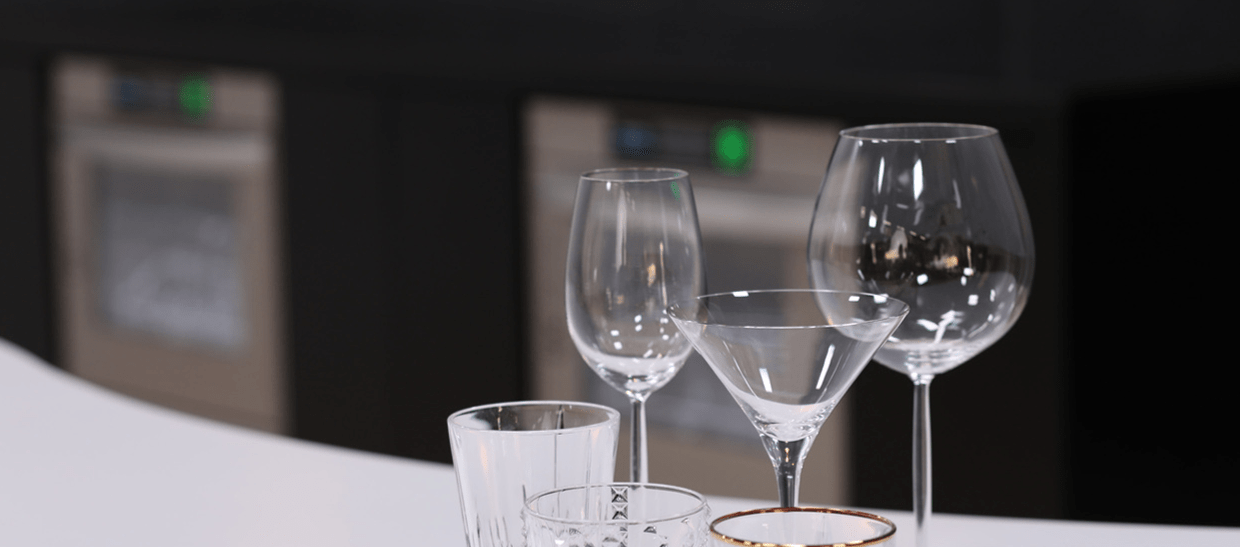
6. COMPARATIVE DATA: HOW DOES IT COMPARE TO A PROFESSIONAL DISHWASHER?
The Winterhalter appliance can reduce washing time by up to 70-80%, thanks to its ability to efficiently process multiple items per cycle. Meanwhile a professional dishwasher does the following:
- Wash faster.
- Ensures consistent results without the need for manual rework.
- It guarantees true hygiene and perfect shine, eliminating the use of scouring pads and rags.
In a medium-sized restaurant with 300 daily services, approximately 1,200 items are washed each day. This translates into hours of work dedicated exclusively to washing, not to mention the physical and mental strain on staff, especially if they must share this task with other responsibilities.
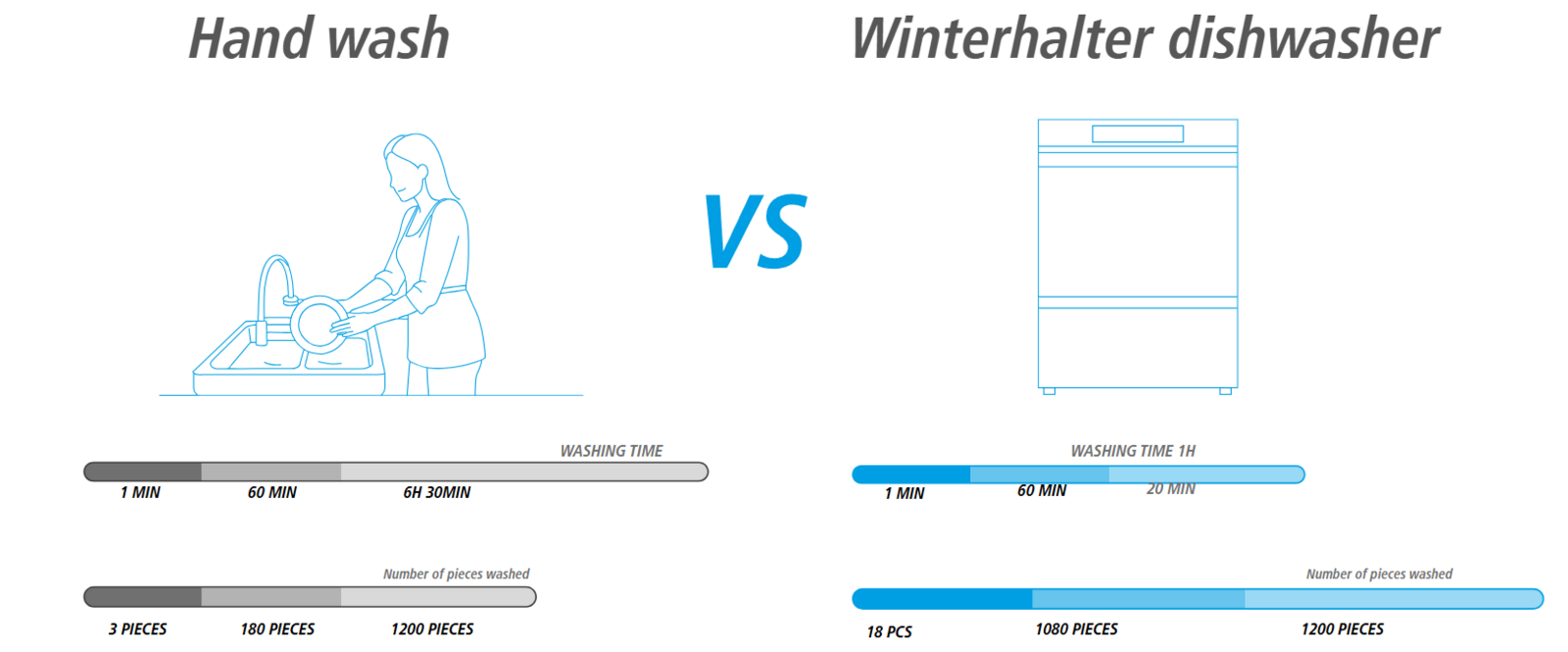
7. TIME OFF
Hand-washing hundreds of plates and cutlery is a tedious task that can often take hours. Traditionally, this work has been delegated to less experienced workers, making them feel less valued than their colleagues and diminishing their interest in working in a professional kitchen.
Furthermore, hand-washing carries associated occupational risks, which translates into your workers taking time off work due to accidents resulting from hand-washing, such as cuts or burns.
Remember that in a professional kitchen, there are never enough hands, and the less time you have your workers spending on inefficient operational tasks like hand-washing, the more time they can spend doing what's truly important to your establishment:
Provide the best dishes with the best presentation and service possible!

8. TECHNICAL
Hand washing isn't always the most hygienic option. Food and product residues often clog the sink, leading to frequent calls to plumbers. Using this surface for dishwashing means additional costs for pipe cleaning, stainless steel maintenance, and other short-term, expensive sanitization efforts.
Hand washing relies on liquid detergents, scouring pads or sponges, and gloves. However, these tools especially scouring pads often fail to maintain consistent cleanliness throughout the process, making it difficult to achieve the level of hygiene expected in a professional kitchen. After each service, gloves and sponges must be replaced or sterilized, adding to

9. DISH HYGIENIZATION PROBLEMS
UP TO 50,000
MILLIONS OF BACTERIA LIVE IN ONE CUBIC CENTIMETER OF A SPONGE
Scouring pads and sponges often become breeding grounds for bacteria over time. Without us realizing, they can contaminate the thin film of water on dishes with a mix of dirt and soap. While this contamination isn’t visible to the naked eye, a simple chemical test reveals it.
At Winterhalter, we demonstrate this with a small dose of iodine, which highlights hidden residues of dirt, proteins, and starches as black spots on what appear to be clean, shiny plates.
We also conduct pH tests to detect detergent residue left behind after manual washing—showing that even with thorough rinsing, soap traces can remain. These residues not only compromise hygiene but can also alter the taste of food.
Dishwashing machines, on the other hand, use specially formulated detergents and rinse aids that ensure true cleanliness and shine—without invisible traces of grease, starch, or bacteria
10. YOU HAVE A DOMESTIC DISHWASHER
The Winterhalter U50 adapts to your kitchen design to offer you reliability and flexibility in your washing process. Its compact wash arm reduces water consumption by up to 70% and decreases wash times, energy costs, and chemical costs.
The smart touchscreen makes the washing system easier for your staff to use and helps you offer your customers exceptional shine and hygiene.
Some restaurants underestimate the volume of plates, cutlery, and glassware required during service and opt for a domestic-style dishwasher. This is a critical mistake, as it forces them to supplement with manual washing, ultimately slowing down the dishwashing process and affecting efficiency.
Additionally, a home dishwasher isn't designed to handle the arduous, continuous workloads that a commercial or industrial dishwasher must endure. This will cause your equipment to fail prematurely and shorten its lifespan.
In this case, your employees, in addition to having to clean the remaining utensils that don't fit in the dishwasher, will have to fill it, unload it, and put away the clean dishes, making having a domestic dishwasher, rather than a helper, a disadvantage.
To clarify the differences with domestic equipment, here we present our line of industrial dishwashers. Winterhalter has been offering its services to companies in the restaurant industry for over 70 years. Thanks to our commitment to innovation and sustainability, we offer washing solutions tailored to each project.
Do you need a professional dishwasher? These are the professional washing solutions that can help you modernize your facilities.
UNDERCOUNTER DISHWASHER
The Winterhalter U50 adapts to your kitchen design to offer you reliability and flexibility in your washing process. Its compact wash arm reduces water consumption by up to 70% and decreases wash times, energy costs, and chemical costs. The smart touchscreen makes the washing system easier for your staff to use and helps you offer your customers exceptional shine and hygiene.

PASSTHROUGH DISHWASHER
This kind of dishwasher is perfect for businesses that need to clean quickly and cater to a large crowd during service (around 100 to 200 services at peak times). The Winterhalter P50 is designed to save you time and use energy efficiently. With its guided self-cleaning program, your business will quickly get used to it, allowing your staff to forget about washing duties.

UTENSILS WASHERS
The Winterhalter UF Series is perfect for even the toughest kitchens, bringing innovation to ensure spotless washing results and top-notch hygiene. This machine is built to handle pots, pans, utensils, and larger pots that need a strong approach to tackle the deepest grime and dirt, effortlessly getting rid of stubborn stains with its high-pressure washing system. Our utensil washer comes with a rack trolley and a folding rack, making it easy and comfortable to use. It's the go-to machine for achieving unmatched cleanliness in demanding environments like bakeries, butcher shops, or professional kitchens.

The MT Series dishwashing solutions are designed to handle high volumes with ease—ideal for busy commercial kitchens in restaurants, hotels, and canteens. Capable of washing up to 10,000 items per hour, they deliver consistently sparkling, hygienic results. Choose between flight-type or rack-type configurations to suit your needs. Elevate your kitchen with Winterhalter and explore our exclusive programs.
